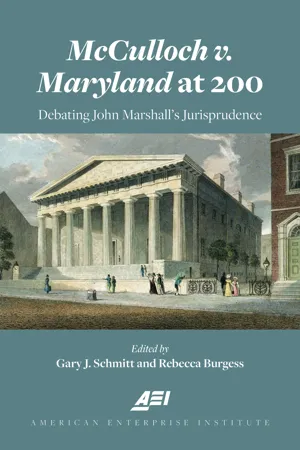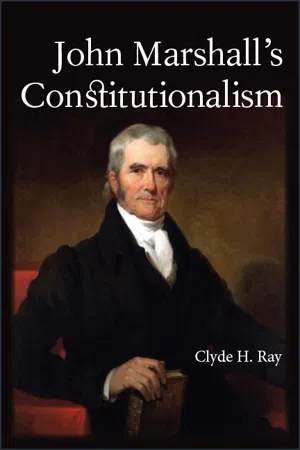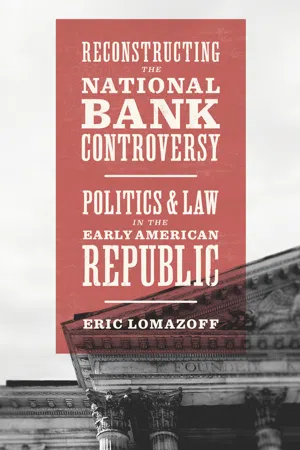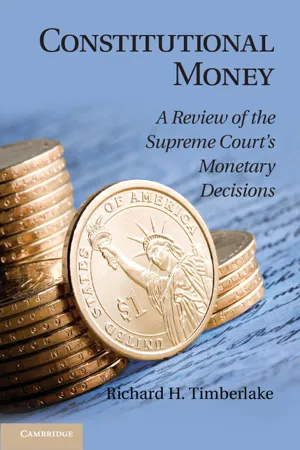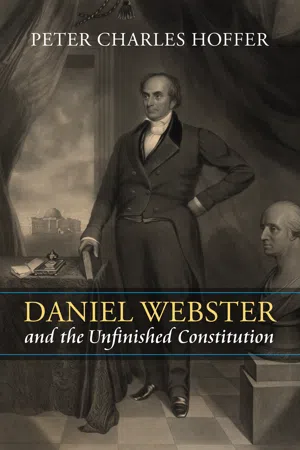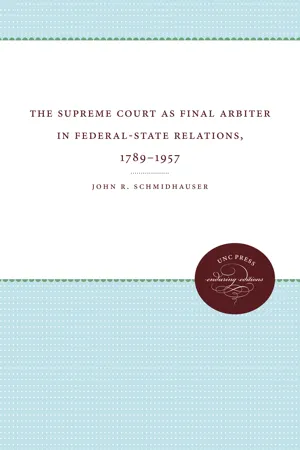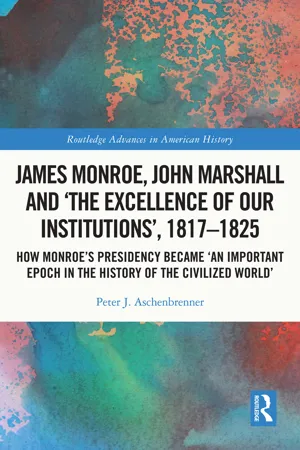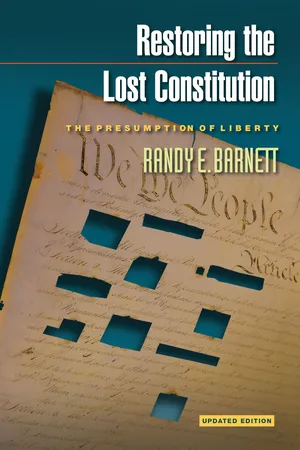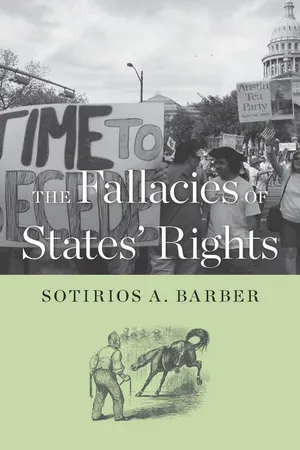Politics & International Relations
McCulloch v Maryland
"McCulloch v. Maryland" was a landmark 1819 Supreme Court case that established the principle of federal supremacy over state laws. The case centered on the constitutionality of the Second Bank of the United States and whether the state of Maryland had the authority to tax it. The Court's ruling upheld the constitutionality of the bank and affirmed the supremacy of federal laws over state laws.
Written by Perlego with AI-assistance
Related key terms
1 of 5
10 Key excerpts on "McCulloch v Maryland"
- eBook - ePub
McCulloch v. Maryland at 200
Debating John Marshall's Juriprudence
- Gary Schmitt, Rebecca Burgess(Authors)
- 2020(Publication Date)
- AEI Press(Publisher)
Introduction: John Marshall and the Politics of McCulloch v. Maryland GARY J. SCHMITTI n recognition of the 200th anniversary of the Supreme Court’s landmark decision in McCulloch v. Maryland, AEI’s Program on American Citizenship commissioned five distinguished scholars to author essays keyed to that decision. The program hosted a panel discussion with the authors to present their initial drafts in late February 2019. The chapters that follow are the finalized versions of those essays. In addition, following the panel presentation and generated by that panel’s discussion, Nelson Lund, university professor at George Mason University’s Antonin Scalia Law School, published a short essay in Law & Liberty onMcCulloch that we asked him to expand and that is now included in our volume.The decision in McCullochfound that the US Congress had the constitutional power to charter a national bank and, further, that Maryland’s effort to tax the bank violated the federal government’s sovereign authority in this matter. As important as the actual decision was, it is Chief Justice John Marshall’s opinion in the case that has gone down in American history as a landmark for its guidance in assessing the constitutional scope of the nation’s legislative authority. Famously, the chief justice wrote:We think the sound construction of the Constitution must allow to the national legislature that discretion with respect to the means by which the powers it confers are to be carried into execution which will enable that body to perform the high duties assigned to it in the manner most beneficial to the people. Let the end be legitimate, let it be within the scope of the Constitution, and all means which are appropriate, which are plainly adapted to that end, which are not prohibited, but consist with the letter and spirit of the Constitution, are Constitutional. - eBook - ePub
- Clyde H. Ray(Author)
- 2019(Publication Date)
- SUNY Press(Publisher)
Although examinations of McCulloch typically begin and end with the opinion itself, this focus can tell one only so much. A full reckoning of McCulloch, and especially Marshall’s political thought, must involve his rare public commentary on the case. In the summer of 1819, Marshall articulated a defense of his McCulloch opinion in the popular press, the sole occasion in his long career of public service when he would engage in a journalistic discussion of any judicial decision. 8 Writing pseudonymously in a number of Virginia newspapers, he expanded on the Court’s opinion, defending it against the attacks of critics. Although these essays have been acknowledged by scholars as providing a more wide-ranging defense of Marshall’s decision, their importance has been considerably undervalued. For the essays provide more than a mere defense or rationalization of McCulloch and consist of far more than partisan bickering. Instead, they go further to offer a full-fledged argument on behalf of Marshall’s concept of constitutional sovereignty. McCulloch v. Maryland Revisited The economically tumultuous years of the late eighteenth century provided the backdrop for McCulloch. 9 When the twenty-year charter of the First Bank of the United States expired in 1811, the Republican Congress, which had always looked askance at the national bank for its centralizing tendencies, successfully blocked its renewal. But the financial strain of the War of 1812 reminded the nation of the need for a streamlined economic system, and the Bank was rechartered in 1816 amid a wave of postwar nationalist euphoria. Upon its renewal, the Bank immediately began opening local branches throughout the country, ignoring objections raised by both private and state-chartered institutions that anticipated a significant loss of business to the national branches - eBook - ePub
Reconstructing the National Bank Controversy
Politics and Law in the Early American Republic
- Eric Lomazoff(Author)
- 2018(Publication Date)
- University of Chicago Press(Publisher)
Chapter SixMcCulloch (1819) in the Shadow of the Compromise
The Conventional WisdomNot long after the rebirth of the national bank, the American economy experienced a severe downturn. Some observers considered the Bank directly responsible for the turmoil because it had recently contracted its lending. Others located the source of the strife elsewhere—the institution’s contraction was merely an effect of that cause—but considered the Bank of the United States guilty of unnecessarily exacerbating the economic pain. Eager to hold someone accountable, Americans (and their elected representatives) targeted the national bank. Many states proceeded to levy heavy taxes on the institution. Maryland’s lawmakers, for example, voted to institute a $15,000 yearly tax on the Bank’s Baltimore branch.After the cashier of that branch—James M’Culloh1 —issued Bank notes without paying the tax, Maryland imposed the statutory fine for behavior of that sort: $100. The state’s courts upheld the tax (and M’Culloh’s fine for failing to pay it), but the US Supreme Court quickly agreed to hear the case on appeal. Just three days after oral arguments in McCulloch v. Maryland concluded, the Court unanimously ruled—through an opinion authored by Chief Justice John Marshall—that (1) Congress had acted constitutionally in chartering the Bank of the United States, and (2) Maryland had acted unconstitutionally in taxing it. The first part of Marshall’s opinion—by “almost any reckoning the greatest . . . [he] ever handed down”2 —offered general reasoning in support of a capacious understanding of federal power and embraced a broad interpretation of the Necessary and Proper Clause. In the eyes of the Court, the final provision in Article I, Section 8 authorized Congress to pass laws that were “convenient, or useful[,] or essential” for - eBook - PDF
Constitutional Money
A Review of the Supreme Court's Monetary Decisions
- Richard H. Timberlake(Author)
- 2013(Publication Date)
- Cambridge University Press(Publisher)
390. McCulloch v. Maryland, 1819 27 Finally, since the Bank would have to obtain a new charter in a few years – by 1836 – no matter what was decided in 1819, the question of the Bank’s legitimacy would soon re-appear in congressional debates. 17 The Bank bill had passed Congress in 1816 by votes of 80 to 71 in the House, and 22 to 12 in the Senate after seven attempts. 18 Given this legis- lative history with all its attendant debate, it perhaps would not have been prudent for the Court to negate years of legislative effort with so little evi- dence of any mischief on the Bank’s part. To the Court in 1819, the status quo seemed harmless and, if necessary, reversible. The McCulloch decision gave the Bank license to continue unmolested by legal roadblocks for another 10 years. During that time it thrived, car- rying on its banking business with discretion and aplomb. How could it do otherwise with all the privileges and advantages it had over rival private institutions? Always in the background, however, was the knowledge that its charter had a time limit, and would have to be renewed before 1836 if the Bank were to continue operating as a national bank. For this reason Nicholas Biddle, the Bank’s controversial President, and the Bank’s direc- tors were careful neither to claim nor to do too much. JACKSON’S COURT ON THE BANK ISSUE After his election as president in 1828, Andrew Jackson reopened the issue of the Bank’s constitutional legitimacy. In his inaugural address, he remarked that, “Both the constitutionality and the expediency of the law creating this Bank are well questioned by a large portion of our fellow citi- zens.” 19 Jackson also claimed that the Bank had failed to provide a sound and uniform currency, an assertion that was undeniably political pretense. The Bank’s influence over the currency was not really at question, only its constitutionality. - eBook - ePub
- Peter Charles Hoffer(Author)
- 2021(Publication Date)
- University Press of Kansas(Publisher)
McCulloch v. Maryland (1819)Webster was no sooner done with his oral argument before the Court in Dartmouth College —indeed the case was still bouncing back and forth between the circuit court, the Supreme Court, and the state courts—when Webster argued for the Second Bank of the United States in McCulloch v. Maryland . Dartmouth College was a case of first importance, but McCulloch was a case of national significance. Like Dartmouth College , the bank case was both political and legal, for the bank was run by National Republicans, the heirs to the Federalists, and the opposition to the bank was led by Jeffersonian Republicans. What was more, unlike Dartmouth College , essentially an intrastate matter, McCulloch directly implicated federalism: could the state of Maryland tax a branch of a bank chartered by Congress? Finally, the bank issue crisscrossed the public/private divide, as the bank itself was a chartered corporation that had both public and private characteristics. All three of the conundrums of the incomplete Constitution came into play in McCulloch . Indeed, in a jurisprudential sense, so far as Webster was concerned, the case was the natural successor to Dartmouth College . And again, it demanded Webster draw boundaries left uncertain by the framers.The recharter of the Bank of the United States (BUS II) in 1816 was not a popular move in many quarters. The first version of the bank, the brainchild of Secretary of the Treasury Alexander Hamilton and financier of the revolution Robert Morris, had a twenty-year lifespan and was not rechartered in 1812. While a national bank was defended as much-needed during the travail of the War of 1812, state banks that had appeared after the demise of the first Bank of the United States were not pleased that a successor was in the works. The problem was the power the BUS II would have to call in the reserves of state banks, when the latter were almost always overextended (having loaned out more than they could cover). In Congress, Daniel Webster proposed a compromise, arguing that some circulating medium acceptable throughout the nation was necessary for interstate and overseas trade. It was in a way the same problem the colonies had faced under the restrictive English currency acts. In 1815 a version of the revised second bank plan created a fund of $30 million, one-sixth of which would be in hard currency and the rest in treasury notes. President James Madison vetoed the plan, however, with a message that suggested the bank did not do enough to revive the credit of the federal government. A year later, in 1816, with peace reestablished, a new bill went through Congress creating a bank with $50 million in capital, chartered for twenty years, with twenty-five directors, five of whom were to be presidential nominees. John C. Calhoun had pushed through the compromise and written the new charter. Constitutional questions of the authority of Congress to create such a bank, a talking point for the opposition during the war, were not pressed, but opposition based on states’ rights doctrine did raise its head. Nevertheless, the bill was passed and signed. The head branch was to be in Philadelphia, and state branches quickly appeared in ten states.1 - John R. Schmidhauser(Author)
- 2016(Publication Date)
- The University of North Carolina Press(Publisher)
As he put it, … the states have no power, by taxation or otherwise, to retard, impede, burden, or in any manner control, the operation of the constitutional laws enacted by congress to carry into execution the powers vested in the general government. This is, we think, the unavoidable consequence of that supremacy which the constitution has declared. Under this doctrine, the Maryland tax on the operations of the Second Bank of the United States was held unconstitutional and void. 16 Indicative of the turbulent opposition to national authority characteristic of the Marshall era was the fact that within a relatively brief span of years two additional cases, Osborn v. Bank of the United States and Weston v. Charleston, 17 involving the same basic issues as the McCulloch case, came before the Supreme Court. They were decided on essentially the same grounds as the McCulloch decision, although several technical questions were raised in the Osborn case which had not been determined previously. 18 The applications of the broad constructionist doctrine of implied powers in the McCulloch and Osborn cases were primarily defensive of federal authority. In the same category can be placed Brown v. Maryland, and Martin v. Mott, 19 The Brown case, like the McCulloch case, involved the constitutionality of a Maryland tax, in this instance a license tax, on importers of foreign commodities. The constitutional issues were whether such a levy interfered with Congress’ power to regulate foreign commerce and whether the tax was a duty on imports prohibited by Article I, section 10, of the Constitution. In holding the tax void, Chief Justice Marshall made it clear that he considered congressional power over foreign commerce to be exclusive. The Maryland levy was held invalid on two grounds. Under the “original package” doctrine, imported commodities were held immune from state taxing authority while retained in the importer’s warehouse in their original forms or packages- eBook - ePub
James Monroe, John Marshall and ‘The Excellence of Our Institutions’, 1817–1825
How Monroe’s Presidency Became 'An Important Epoch in the History of the Civilized World'
- Peter J. Aschenbrenner(Author)
- 2022(Publication Date)
- Routledge(Publisher)
McCulloch decision was announced.Two centuries of scholars have offered divergent opinions on Marshall’s textual and structural arguments. I sampled thirty-six studies published from 1826 to 2012. To some the word ‘necessary’ was critical in parsing McCulloch. This term brings in a reference to Article I, Section 8, Clause 18, the Necessary and Proper Clause. ‘The Congress shall have Power … To make all Laws which shall be necessary and proper for carrying into Execution the foregoing Powers, and all other Powers vested by this Constitution in the Government of the United States, or in any Department or Officer thereof’. On this account McCulloch is a case about constitutional text. James Kent’s Commentaries on American Law (1826 ) grounded the ‘whole opinion [on] the idea that … the bank was necessary and proper’, as does James Bryce’s American Commonwealth (1888 ) which also relies on the Necessary and Proper Clause.12 To Kent and Bryce the constitutional text authorizing Congress to make laws ‘necessary and proper’ served as the foundation for Marshall’s reasoning.Another school of thought – nearly half of the scholars surveyed – ignored the Necessary and Proper Clause altogether. These scholars referred to arrangements set in place when the Philadelphia convention composed Constitution II, after which it was ratified by the 13 original states (1787–1790). On their account McCulloch was a case about constitutional structure. For example, Charles Warren’s Supreme Court in United States History discarded the court’s reasoning.13 The ‘degree of [the bank’s] necessity was solely for … Congress’ to decide, a position that Jean Edward Smith embraced in hisJohn Marshall, Definer of a Nation.14 Alexander Bickel concurred with Warren: his study The Least Dangerous Branch found the ‘nature’ of the constitution offering ‘hospitality to large purposes’, relieving Bickel of the chore of citing to the constitution. Bickel relied heavily on James Bradley Thayer’s article ‘Origin and Scope of the American Doctrine of Constitutional Law’.15 G. Edward White’s The Marshall Court and Cultural Change likewise followed the minority view.16 His contribution to The Oliver Wendell Holmes Devise History of the Supreme Court of the United States made McCulloch turn on ‘implied sovereign powers’, powers both vast and unenumerated.17 - eBook - ePub
Restoring the Lost Constitution
The Presumption of Liberty - Updated Edition
- Randy E. Barnett(Author)
- 2013(Publication Date)
- Princeton University Press(Publisher)
If on the one hand congress are not limited in the choice of the means, by any such appropriate relation of them to the specified powers, but may use all such as they may deem capable of answering the end, without regard to the necessity, or propriety of them, all questions relating to means of this sort must be questions of mere policy, and expediency, and from which the judicial interposition and control are completely excluded. 133 Although David Currie suggests a more restrictive interpretation of McCulloch than it was given by its critics at the time, it is the latitudinarian gloss on the meaning of “necessary” that survives to this day largely unchallenged. While Marshall’s fear of impotent government remains a matter of speculation (because he got his way), history seems to have borne out Madison’s and others’ expressed concern for the integrity of the enumerated powers scheme. With rare exception, the enumeration of powers has largely been vitiated as a limitation on the scope of the national government, owing in no small measure to the influence of Justice Marshall’s opinion in McCulloch. As Stephen Gardbaum has observed, McCulloch is one of the handful of foundational decisions of the Supreme Court that are automatically cited as original sources for the propositions of constitutional law that they contain. But McCulloch has the further (and even rarer) distinction of being treated as providing a full and complete interpretation of a particular clause of the Constitution. Analysis of the Necessary and Proper Clause has historically begun and ended with McCulloch … 134 Therefore, it is supremely ironic that, like the other leading figures already discussed, John Marshall, too, insisted that the courts should not cede unlimited discretion to Congress. In a practice we would today think bizarre, Marshall responded to the torrent of condemnation with a pseudonymously published defense of his own opinion in McCulloch - eBook - ePub
- Sotirios A. Barber(Author)
- 2013(Publication Date)
- Harvard University Press(Publisher)
Maryland (1819) remains the leading statement of national federalism. 1 Though Marshall failed to confront the full implications of his position either in McCulloch or elsewhere, McCulloch displays the essential premises of a national vision with as much clarity and as little equivocation as one could reasonably expect from a democratic statesman addressing a divisive public question. The most striking feature of the McCulloch opinion is its pervasive instrumentalism: the view that government and law are chiefly about means to desired ends, essentially the people’s happiness. Marshall’s instrumentalism stretches from his theory of the Constitution’s origin (who established the Constitution and why) to his views of the nature of governmental powers, the questions judges should ask in federalism cases, and who bears the burden of persuasion in such cases. Credit also goes to Marshall’s critics, however, for they exposed the further implications of Marshall’s instrumentalism, and these implications are indeed unsettling to the conventional ear. Critics charged that Marshall would sacrifice both federalism and republicanism and put the country on a path to both unitary (or “consolidated”) government and government by a moneyed elite. Under two pen names, Marshall took to the popular press to deny these charges. As we shall see in Chapter 3, however, he might better have demurred. Marshall’s critics were right in important respects, and the public might well have accepted elements of each charge. This is especially true since, as Chapter 4 shows, Marshall’s critics spoke for a negative constitutionalism (the Constitution as essentially a restraint on government) that was and remains untenable. John Marshall’s Nationalism Marshall’s opinion in McCulloch is widely known, its key passages among the most quoted in the constitutional literature - eBook - PDF
The Legislative Branch of Federal Government
People, Process, and Politics
- Gary P. Gershman(Author)
- 2008(Publication Date)
- ABC-CLIO(Publisher)
By its silence, considered in connection with the decision of the Supreme Court in the case of McCulloch against the State of Maryland, this act takes from the States the power to tax a portion of the banking business carried on within their limits, in subver- sion of one of the strongest barriers which secured them against Federal encroach- ments. Banking, like farming, manufacturing, or any other occupation or profession, is a business, the right to follow which is not originally derived from the laws. Every cit- izen and every company of citizens in all of our States possessed the right until the State legislatures deemed it good policy to prohibit private banking by law. If the pro- hibitory State laws were now repealed, every citizen would again possess the right. The State banks are a qualified restoration of the right which has been taken away by the laws against banking, guarded by such provisions and limitations as in the opinion of the State legislatures the public interest requires. These corporations, unless there be an exemption in their charter, are, like private bankers and banking companies, subject to State taxation. The manner in which these taxes shall be laid depends wholly on leg- islative discretion. It may be upon the bank, upon the stock, upon the profits, or in any other mode which the sovereign power shall will. Upon the formation of the Constitution the States guarded their taxing power with peculiar jealousy. They surrendered it only as it regards imports and exports. In relation to every other object within their jurisdiction, whether persons, property, business, or professions, it was secured in as ample a manner as it was before possessed. All persons, though United States officers, are liable to a poll tax by the States within which they reside.
Index pages curate the most relevant extracts from our library of academic textbooks. They’ve been created using an in-house natural language model (NLM), each adding context and meaning to key research topics.
